2.1 Introduction
Among the more than 25 species of Macaca, the Tibetan macaque (Macaca thibetana) is relatively late to be known in primatology. There are several reasons for this. First, it had been considered as a subspecies of Macaca speciosa until Fooden (1983), based on his re-examination of the form and size of the glans penis and baculum and the structure of the female reproductive tract, elevated it to species status. Second, Tibetan macaques are endemic to east central China, where most of them inhabit high mountains with dense forests and cliff ledges, making field studies very challenging. Third, as argued above (Sun et al. 2019), there were few Chinese researchers interested in studying primates until the 1980s. As a result, the population status, life history, and social organization of M. thibetana have remained relatively poorly known.
Existing information, though still limited, indicates that the Tibetan macaque may be special in many ways. Morphologically, it resembles the stump-tailed macaque, M. arctoides (Delson 1980). Phylogenetically, it is close to the Assamese macaque, M. assamensis, as indicated by both morphological (Delson 1980) and genetic analyses (Hoelzer et al. 1992). Ecologically and behaviorally, it is more similar to the Barbary macaque, M. sylvanus, because both live in montane habitats near the subtropical/temperate boundary, have a similar diet, and share intensive infant care with “bridging behavior,” which involves two adults simultaneously lifting up an infant (Ogawa 2019). Yet, the four abovementioned species have been placed into different species groups within the genus Macaca by Fooden (1980) and Delson (1980), leading Wada et al. (1987) to suggest that the Tibetan macaque is a key species for understanding the evolution of Asian Macaca. These are the main reasons why M. thibetana has attracted much interest among primatologists lately.
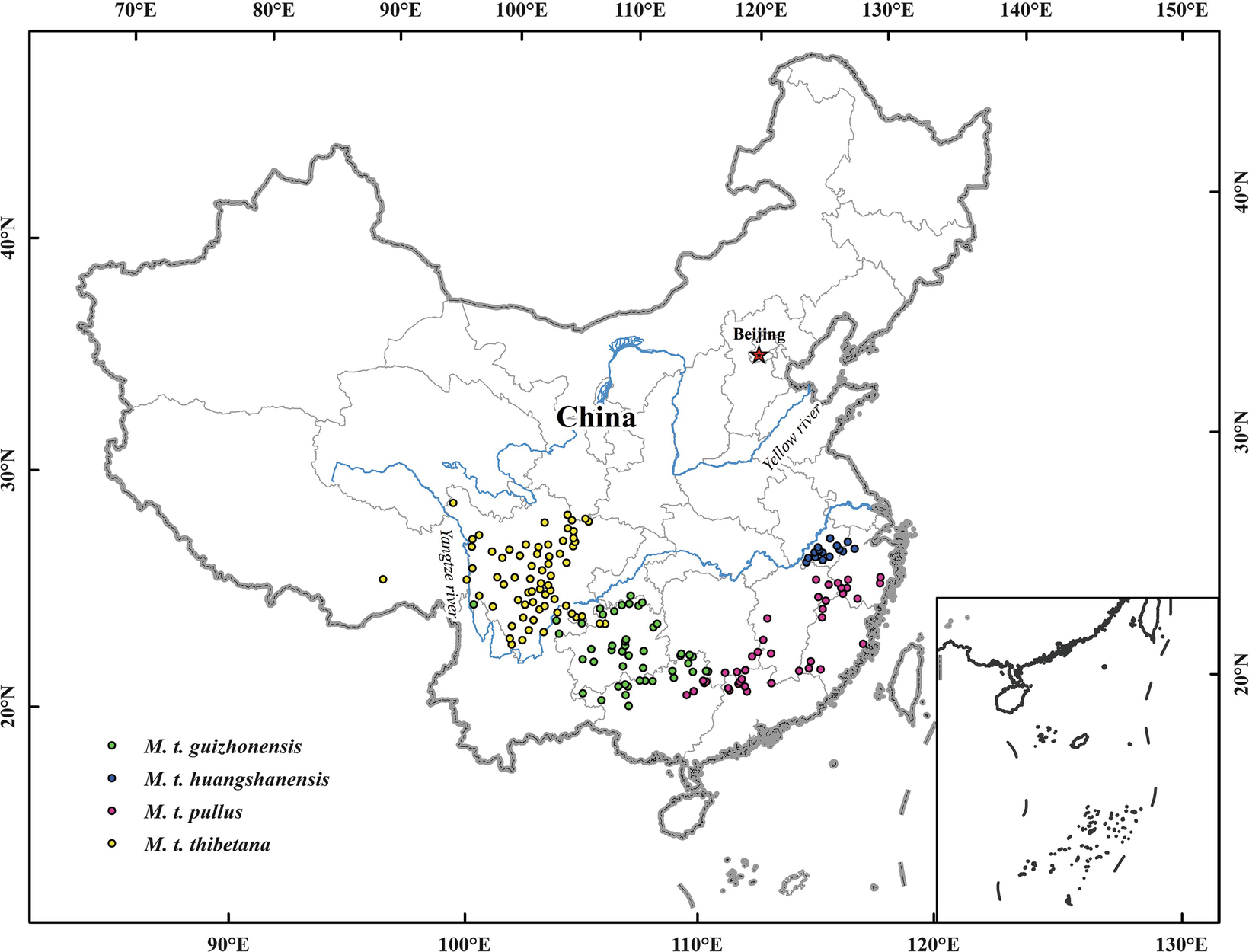
Geographical distribution of the four subspecies of Macaca thibetana in China. The species sporadically inhabits in the mid-east region of China, along the Yangtze River
2.2 Long-term Study of Tibetan Macaques at Mt. Huangshan
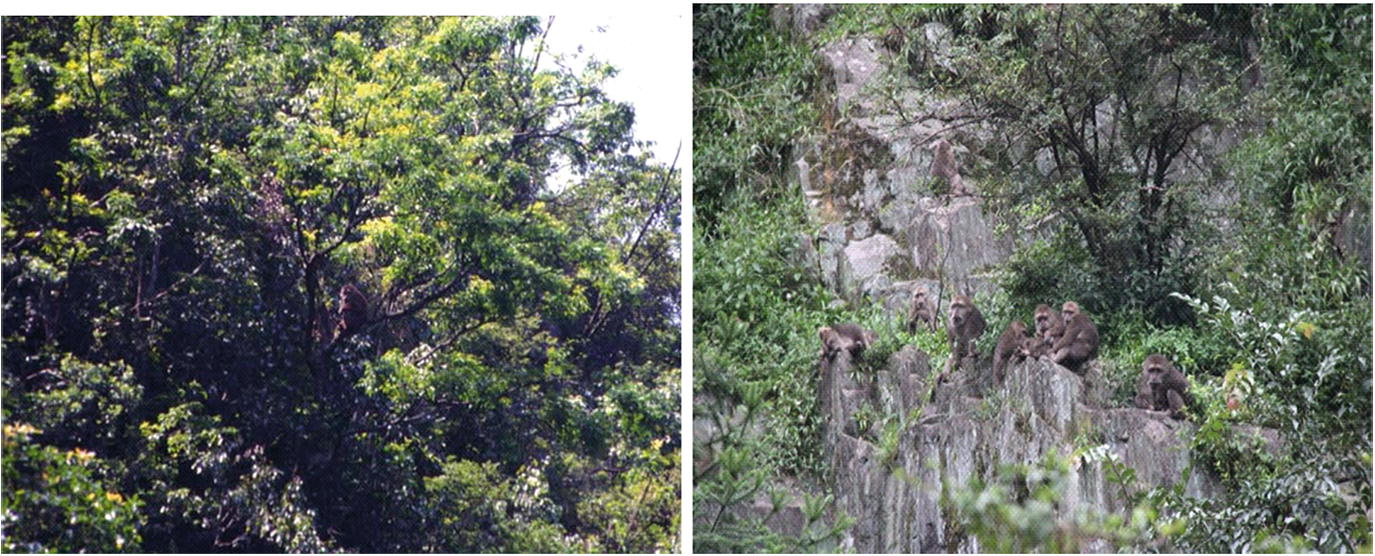
Tibetan macaques inhabit high mountains with evergreen broad-leaved forest (left) and rocky cliffs (right)
Two primate species inhabit these mountains: the Tibetan macaque and the rhesus macaque (M. mulatta). Tibetan macaques inhabit higher altitudes above 600 m asl with rocky cliffs, whereas the rhesus macaques live in lower areas with a relatively continuous distribution (Wada et al. 1987). Both have been strictly protected from hunting and trapping since the 1940s and have no known large predators.
Nine social groups of Tibetan macaques are currently living in Mt. Huangshan, where they maintain apparently nonoverlapping home ranges (Wada et al. 1987). They occur in two types of forest and mixed forest: the evergreen broad-forest between 500 and 1000 m asl and deciduous and evergreen mixed broad-forest between 800 and 1200 m asl. They are heavily reliant on structural plant parts for food with marked seasonality: bamboo and grass shoots in spring; fruits, nuts, acorns, and tubers in fall; and bark and mature leaves in winter, supplemented with invertebrates year-round (Xiong and Wang 1988). Geophagy has been observed in terms of ingesting yellow clay from well-established spots and licking rocks that are in contact with soil (Wang et al. 2007). In winter, Tibetan macaques huddle together and sleep on the terraces of rocky cliffs (Xiong 1984), but in summer, they spend the night in trees, which are cool and are safe from venomous snakes (Li and Wang 1994).
Our long-term study group is named Yulingken group (lately Yulingken A or YA1 following a recent group fission) at the village of Fuxi in the southern part of the mountain. The group has been monitored continuously since 1986. To facilitate observation, we have provisioned the group with dried maize to attract them to an open area by a stream. An amount of 5–6 kg of maize per day, which is about 1/3 of the daily food intake of the group, has been given by local wardens 3–4 times a day on a set schedule. When not being fed, the macaques spend most of their time in the forest near the provisioning area. Provisioning has made it possible for us to study the group in a steep terrain and has prolonged our observational time, though it may inevitably affect their natural activities to some extent (Matheson et al. 2006).
We set up a standard study protocol for long-term collection of consistent data within and among researchers at the beginning of the study in 1986. Since then, we have recognized individuals from birth on (natal individuals) or first discovery (immigrated individuals) and given them Chinese names. We have identified each group member based on individually specific physical characteristics such as body size, fur color, facial features, and body scars and taken pictures for confirmation and comparison over time. Furthermore, since Tibetan macaques have broad faces and long fur, both of which change with age, we can fairly reliably sort them into age-sex groups: infant (<1 year), juvenile (1–3 years), adolescent (♂3–7 years, ♀3–5 years), young adult (♂7–10 years, ♀5–10 years), middle-aged adult (10–15 years), and old adult (>15 years). Our records show that a male can live up to 28 years (Gaoshan) and a female up to 33 years old (Hua). They both died of old age. Because all females in the group have been identified after their births, we have been able to trace matrilineal relationships among all group members since 1983. Recently, we used microsatellite DNA markers to determine paternity for most group members (Appendix I). For behavioral data collection, we have followed Altmann’s methods (Altmann 1974) and recognized and defined 33 distinct social behaviors (Li 1999, see Appendix II). In order to conduct genetic, physiological, and microbiological analyses, we have developed noninvasive techniques to collect cell or hormone samples from the feces and saliva of living monkeys (Zhao et al. 2005; Simons et al. 2012).
The long-term study of Tibetan macaques at Mt. Huangshan has been ongoing for over 30 years. It is the longest research project for wild primates in China. More than 150 researchers and students from the United States, Japan, Australia, England, and Germany as well as China have visited or conducted research at our field site, and 50 theses and 12 dissertations have been completed. This project is now recognized among the eight sites in the world for the long-term study of free-living monkeys (Kappeler and Watts 2012). Recently, as an integral part of the International Research Center for Huangshan Biodiversity and Tibetan Macaque Behavioral Ecology, the project has been approved by the Anhui provincial government.
2.3 Social Life History Strategies
2.3.1 The Largest Macaca
Body weights (kg) of some Macaca species
Species | Adult male | Adult female | Neonate |
|---|---|---|---|
M. thibetana | 16.4 | 11.0 | 0.60 |
M. fuscatta | 11.7 | 9.1 | 0.50 |
M. sylvanus | 11.2 | 10.0 | – |
M. nemestrina | 10.4 | 7.8 | 0.47 |
M. nigra | 10.4 | 6.6 | 0.49 |
M. maura | 9.5 | 5.1 | – |
M. arctoides | 9.2 | 8.0 | 0.49 |
M. silenus | 6.8 | 5.0 | – |
M. radiata | 6.6 | 3.7 | 0.40 |
M. sinica | 6.5 | 3.4 | – |
M. mulatta | 6.2 | 3.0 | 0.48 |
M. fascicularis | 5.9 | 4.1 | 0.35 |
2.3.2 Medium-Sized Group with Even Adult Sex Ratios
We monitored the size and composition of Yulingken group annually and found a fluctuation of 21–51 individuals with an average of 35.3 individuals (SE = 1.6) over the 30 years from 1987 to 2017. Whenever group size reached about 50 individuals, it fissioned into two subgroups and the smaller one of the two subgroups left the study area. During this period, we recorded four fission events happening in 1993, 1996, 2001, and 2003, respectively (Li et al. 1996; Li 1999; Berman and Li 2002), and noticed that males and females who were relatives tended to separate on these occasions (Li et al. 1996). Thus, Tibetan macaques at Mt. Huangshan appear to live in medium-sized groups, in comparison with the 70–80 and sometimes more than 100 individuals found in groups of other macaque species (Macintosh et al. 2012; Waters et al. 2015). Group size is an important component of social organization that determines how many individuals a group member can potentially interact with, which in turn contributes to social complexity (Kappeler and Watts 2012).
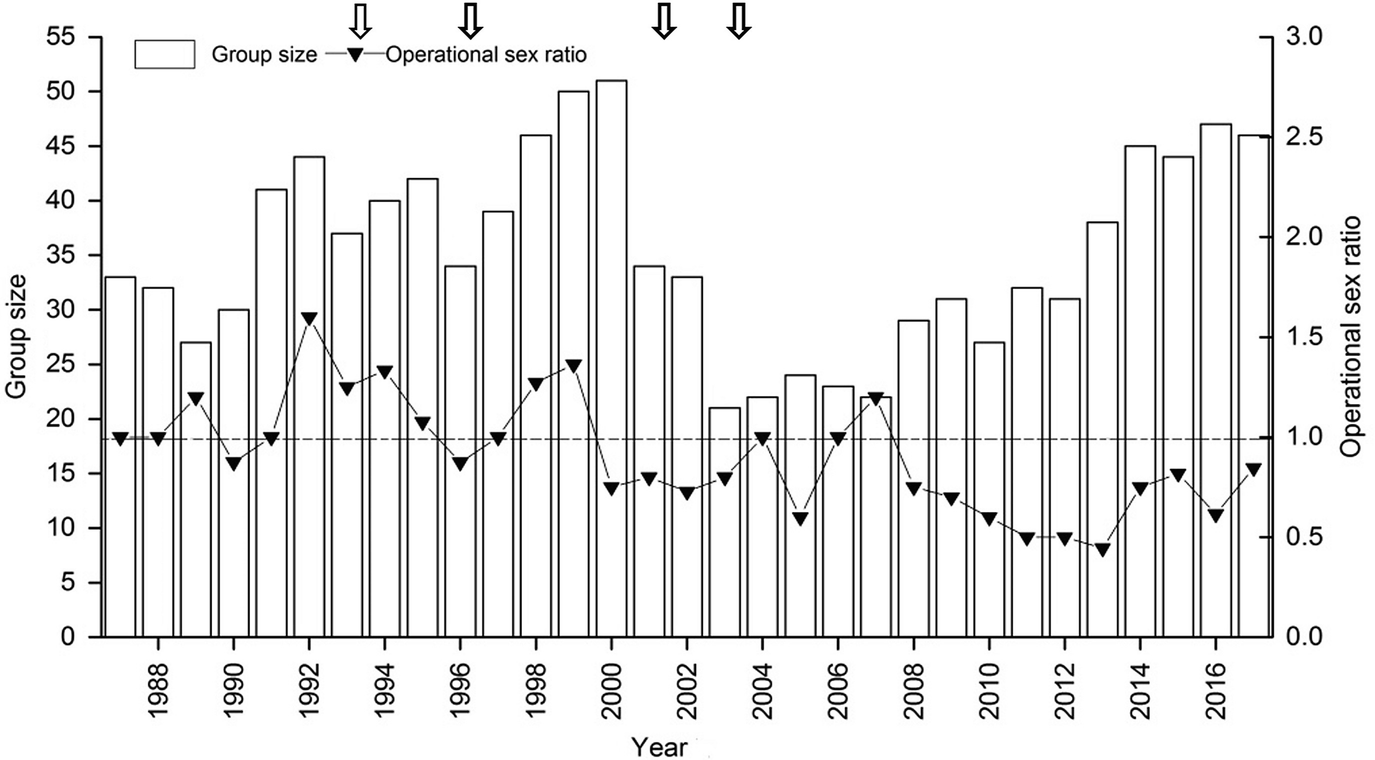
Dynamic of group size and operational sex ratio of male to female in Yulingken A1 group during 1986 and 2017. Down arrow refers group fission events
2.3.3 A Rich Repertoire of Affiliative and Ritualized Behaviors
An important feature of Tibetan macaques is their rich repertoire of affiliative and ritualized behaviors. Of the 33 social behaviors we have identified, at least 17 (> 50%) include affiliation (Li 1999). Like other macaques, allogrooming (social grooming) is widespread among all group members and takes up about 20% of daily time expenditure (Wang et al. 2007). Females and juveniles are more active groomers than males in peaceful situations. Grooming is more frequent between sexual partners than between other male–female pairs. Specifically, higher-ranking males, including alpha males, groom females for a short time after copulation or during consortship. Grooming between adult males is also frequent (Xia et al. 2013). When two individuals meet, the lower-ranking individual usually presents to the high-ranging individual. If the two individuals are both males, they may embrace each other, sometimes with their hands stretching out to grasp the genitals of their partners. Additionally, the lower-ranking individual may approach a higher-ranking one, showing its penis to be sucked by the partner, or the higher-ranking individual touches a part of the body (head, back, or shoulder) of the lower-ranking individual or mounts the lower-ranking individual with teeth chattering. If the two individuals are of the opposite sex, the male may grimace at the female, and the female approaches the male for genital inspection, before copulation ensues. Also, during conflicts between two females, a third, higher-ranging female may often approach and hold the bottom of the attacking female to stop further aggression.
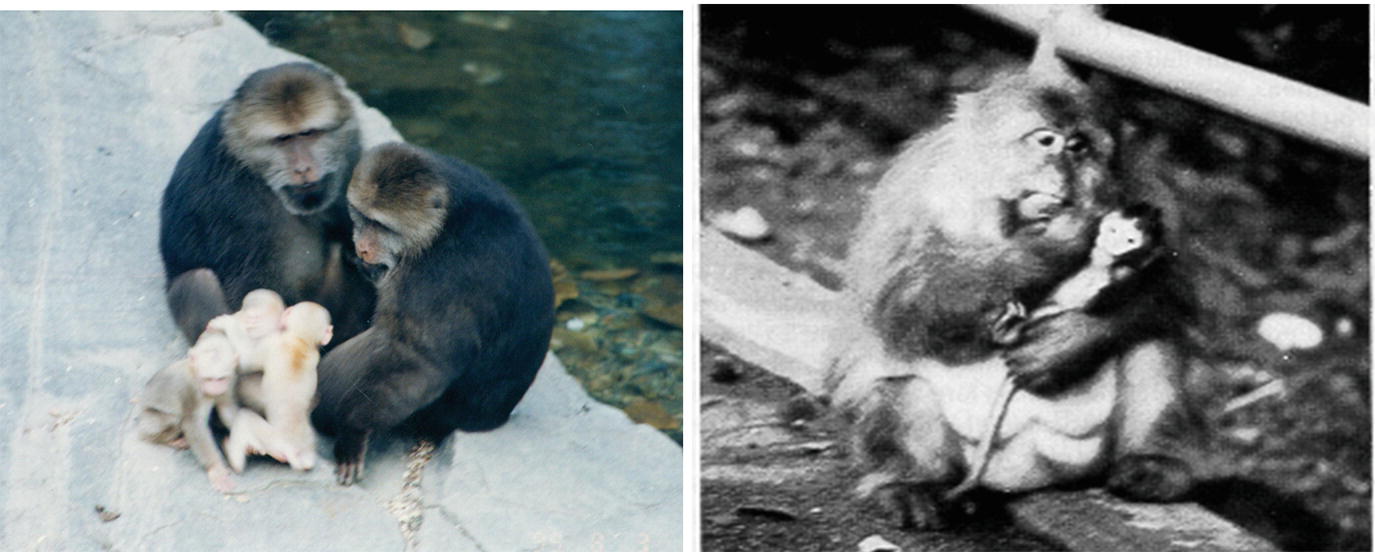
Infant-holding behavior in Tibetan macaques is common. Left: three infants are attracted to two adult males, apparently waiting to be held or used in bridging. Right: a male Tibetan macaque living alone in Kowloon in Hong Kong holds an infant long-tailed macaque
2.3.4 Despotic Dominance Style
The dominance style concept has proven useful for understanding covariation patterns in relationship qualities, particularly among macaques (Berman et al. 2004). As a member of the sinica lineage, Tibetan macaques are predicted to have a relaxed dominance style (Matsumura 1999; Thierry 2000). Previous studies did indicate relaxed dominance in this species. For example, males frequently engage in ritualized greetings in which they groom, mount, embrace, or touch each other’s genitalia (Li 1999). In addition, both sexes engage in frequent bridging, and infants’ mothers appear to be tolerant of infant handling by a wide range of group members (Ogawa 1995a).
However, a detailed study indicated that Tibetan macaques are more despotic than previously suspected. Bidirectional aggression, including counter-aggression (1.9%) and conciliatory tendency (6.4%), was consistently low in frequency across partner combinations, seasons, and locations (Berman et al. 2006). Females consistently displayed high levels of kin bias in affiliation and tolerance. Compared to other macaque species with better known dominance styles, data from Tibetan macaques generally fall within the range characteristic of despotic species and outside the range of relaxed species (Berman et al. 2004).
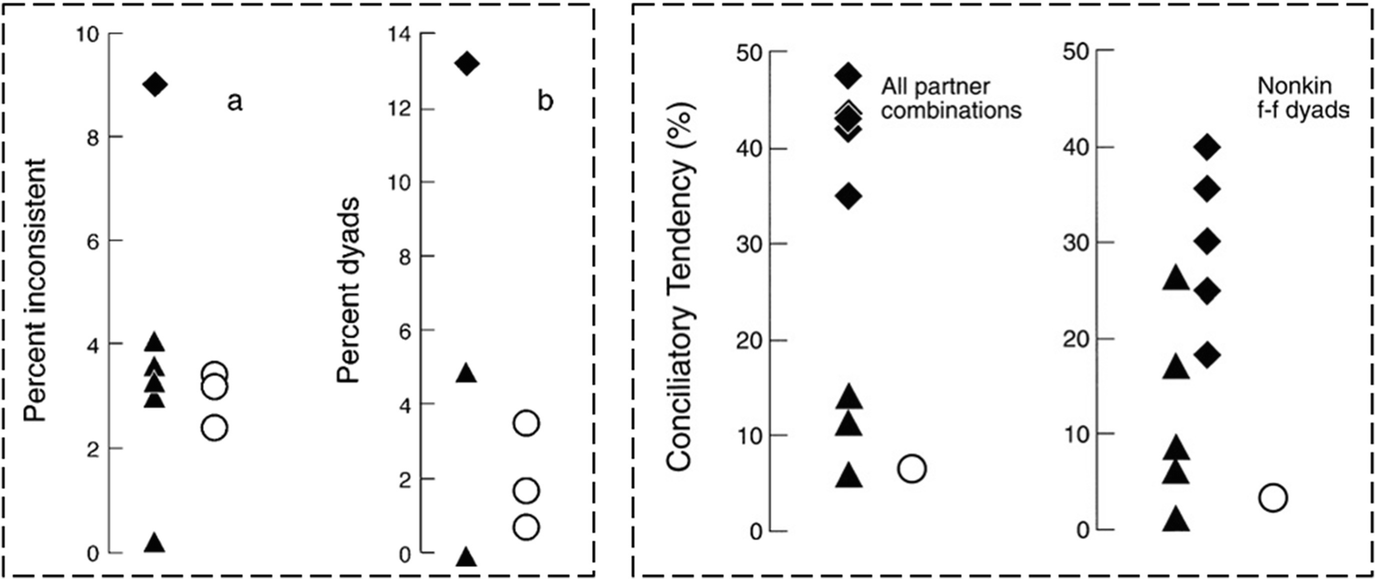
Bidirectionality of aggression (left) and conciliatory tendencies of Tibetan macaques (right). Both a directional inconsistency index (a) and dyads-up index (percentage of dyads in which the primary direction of aggression is up the hierarchy of three data points representing three study periods for Tibetan macaques (circles)) fall within the range of despotic macaques (rhesus, long-tailed and Japanese macaques) (triangles) and are considerably lower than the one relatively relaxed species (stump-tailed macaques) (diamonds). Conciliatory tendencies of Tibetan macaque in (1) all partner combinations and degrees of relatedness combined, and (2) unrelated female–female partners (circles) are relatively low, even compared to values for despotic macaques (triangles). Data from Berman et al. (2004)
2.3.5 Reproductive Pattern with Year-Round Mating but Seasonal Births
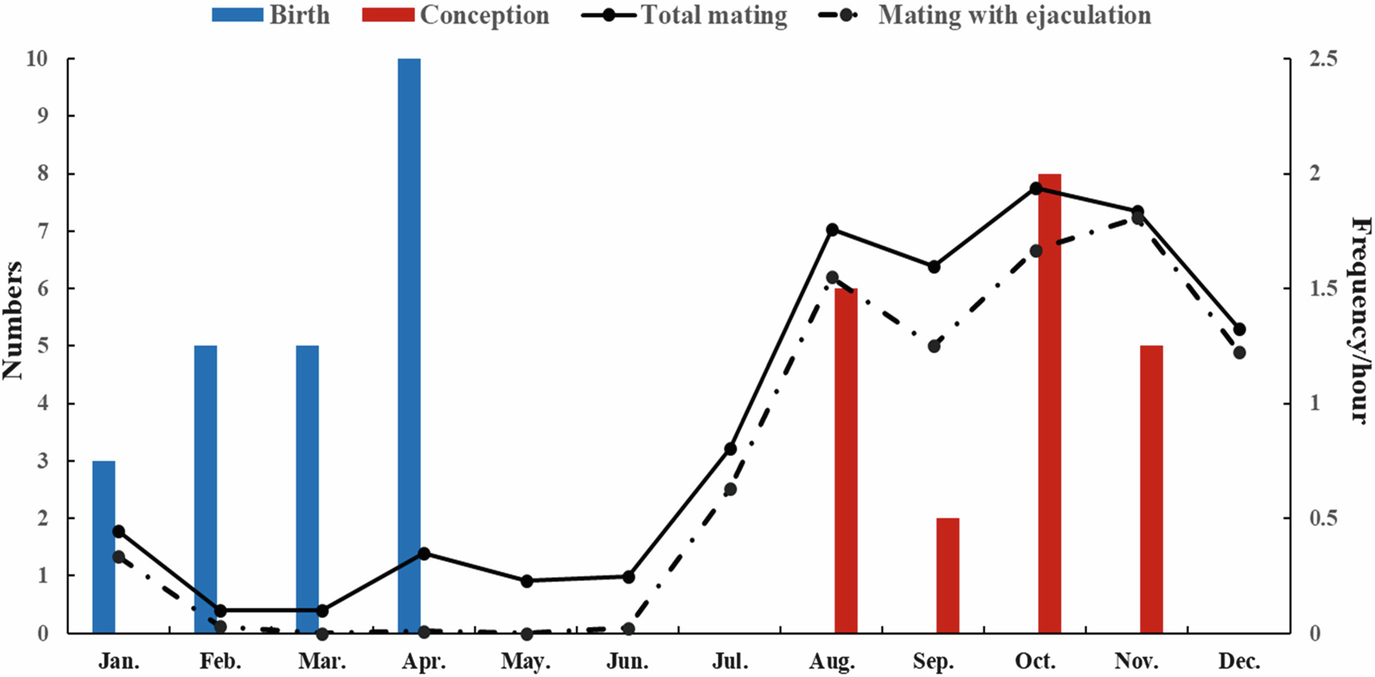
Annual reproductive cycle of Tibetan macaques. Though Tibetan macaques mate year-round (solid line), mating with ejaculation (dotted line) is confined to a period from July to December. Therefore, the mating season is from July to December, and the birth season is from January to April
In order to explain this unusual reproductive pattern of Tibetan macaques, we investigated changes in the female sexual skin and nonreproductive matings in more detail. We found that adult females had a slight but detectable sexual skin in the perineal region, but the sexual skin lacked the regular changes characteristic of the physiological cycle of a female or the reproductive season. Females also had no typical behaviors to show their sexual motivation during estrus. This led to the conclusion that Tibetan macaques have concealed ovulation (Li et al. 2005). Further study revealed that males could discriminate between potentially receptive females, but that they could not recognize the reproductive status of a given female (Li 1999; Zhang et al. 2010). Concealed ovulation may result in a higher mating frequency during a female’s receptive period.
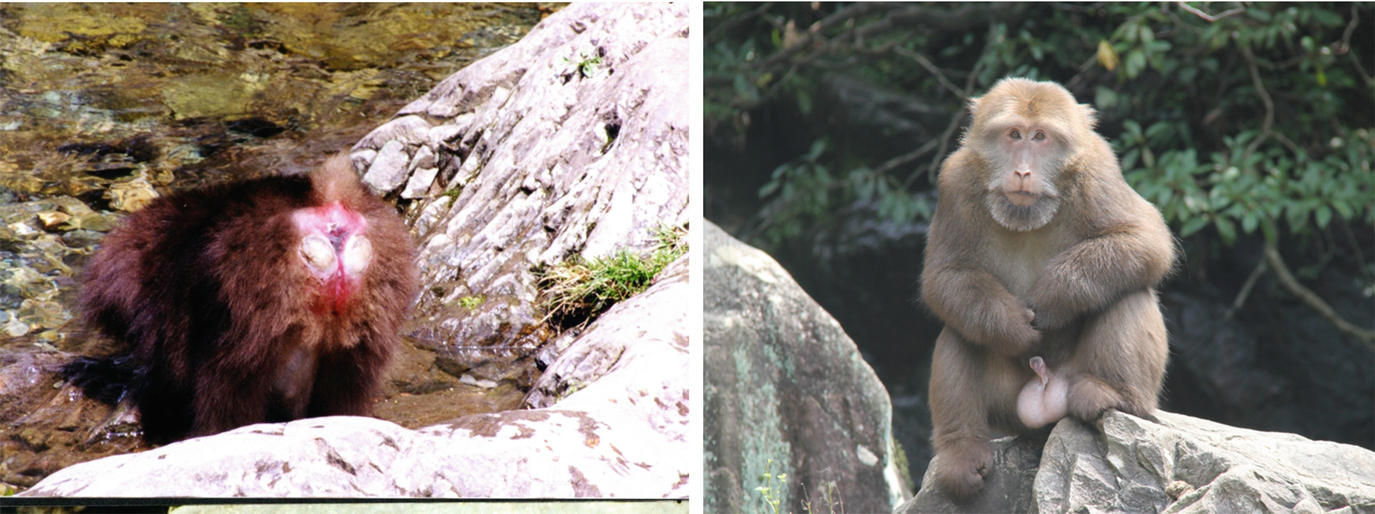
Inconspicuous sexual skin in adult females (left) and large testes in adult males (right) in Tibetan macaque
It is worth noting that an important aspect of the mating pattern of Tibetan macaques at Mt. Huangshan is a single mount ejaculation (SME), with average duration and thrust numbers of 23.2 s and 20 times, respectively (Xiong and Wang 1991). High-ranking males copulate more often with more females than do low-ranking males, and alpha males monopolize over 2/3 of all matings (Xiong and Wang 1991; Li et al. 2005). However, it has been reported that Tibetan macaques at Mt. Emei exhibit serial or multiple mount ejaculation with a mean duration and thrust number of mounts with 30.3 s and 43.3 times (MME), respectively (Zhao 1993). Since no data on the number of mounts in a MME have been provided, we do not know whether the difference is due to a difference in populations per se or observation methods.
Finally, females at the age of 7–12 years have the highest birth rate. Not only are birth rates of high-ranking females higher, but those of high-ranking females are also earlier than those of low-ranking ones in the birth season (Li et al. 1994).
2.4 Potential Contributions to Understanding Behavioral Mechanisms in Primate Societies
2.4.1 Bridge and Bond Role of Infant
Tibetan macaques exhibit some interesting and unique behavior patterns. Bridging behavior is one of them. Bridging involves two individuals and an infant and is a triadic interaction. Bridging behavior is common in Tibetan macaque society, and it can be performed between males, between females, between a male and a female, and even between an adult and a juvenile. Infants of both sexes are involved in the “bridge.” Despite this variation in bridging partners, bridging lasts only a few seconds. Once bridging has ended, the two bridging individuals often groom each other or sit together, ignoring the infant. Obviously, the “bridge” between monkeys is not for infant care, but for social contact or communication. In other words, infants are a “social tool” used to facilitate older group members’ associations and interactions (Ogawa 1995b). Zhao (1996) even compared infants in bridging behavior to a cigarette-like social facilitator in human social interactions.
Primatologists have always paid particular attention to the role of infants in nonhuman primate societies. However, most studies have focused on infant care or handling (Ogawa 1995a). For example, in capped langurs, Presbytis pileata, newborn infants of less than one month old spend nearly the same amount of time with alloparental females as with their own mothers (Stanford 1992). Likewise, young, female vervet monkeys, Chlorocebus aethiops sabaeus, without infants hold or carry newborn infants, which has been explained as alloparental investment (Fairbanks 1990). Bridging behavior has also been observed in M. sylvanus (Deag and Crook 1971). Clearly, infants in Tibetan and Barbary macaques play an active part in enhancing social relationships among group members. This is a relatively new and important research direction that is worthy of further exploration.
2.4.2 Male-Female Friendships in a Promiscuous Mating System
During the mating season from July to December, high-ranking Tibetan macaque males often follow sexually receptive females (usually those without unweaned infants). They move, feed, and rest together, often accompanied by mating; that is, they form a temporary consortship. The duration of such a consortship varies from a few days up to over 2 weeks (Li 1999). During a consortship, the male always keeps close with the female, and the male’s activities are restricted by the female’s movements. Sometimes, when a consorting male realizes that his female has disappeared, he shows signs of anxiety and searches for the female everywhere.
The role of consortship is unclear at present. On the one hand, the duration of consortship in Tibetan macaque is rather long, lasting as much as 18 continuous days (Li 1999). This does not only exceed the time needed to impregnate a female, but is also longer than the duration in other Macaca species (Li 1999). On the other hand, although a male follows one female at a time, usually he cannot monopolize all of her matings even though he is the alpha male. So why do high-ranking males use consortship as a mating tactic?
We already mentioned that female Tibetan macaques tend to conceal their ovulation by neither showing cyclical fluctuation of sexual skin nor estrus-related behaviors (Li et al. 2005). Although high-ranking males form consortship with females, they are able to opportunistically mate with other sexually receptive females, too. Thus, the co-occurrence of consort behavior and opportunistic mating may indicate a male mating tactic that is effective when mating is promiscuous and males cannot accurately detect ovulation in females from morphological and behavioral signs. That is, consortship may be a tactic related to the assurance of paternity. From an evolutionary perspective, consortship in Tibetan macaques appears to be a special type of sexual relationship, which has also been reported for some baboons, where they have been labeled as “friendships” (Smuts 1985).
2.4.3 Competitive and Cooperative Relationships Among Males
Male Tibetan macaques exhibit stable, linear dominance hierarchies typical of despotic species. On the one hand, aggression is frequent and can be accompanied by serious wounds in all sex/age classes (Berman et al. 2004; Li 1999). Additionally, the large body, large testes, and short tenures of alpha males (on average about 10 months) indicate intense competition among males (Li and Wang 1996). On the other hand, Tibetan macaque males frequently engage in friendly behaviors, such as grooming and sitting together, and engage in ritualized greetings involving mounting, embracing, and sucking penis. Many of these behaviors are rarely seen in other Macaca males. Tibetan macaque males also quickly reconcile after aggression. The conciliatory tendency is 19.7% in male–male dyads, compared to 4.2% in female–female dyads, and most male–male reconciliations occur within 1 min after aggression (Berman et al. 2004). It is evident that male Tibetan macaques show both competitive and cooperative relationships. This appears to agree with observations taken from other primate societies with relatively male-biased adult sex ratios.
2.4.4 Behavioral Mechanism Promoting Genetic Diversity in a Small Group
Like most nonhuman primates in China, Tibetan macaques live in small, isolated populations. Theoretically, a small population or group may suffer the detrimental effects of inbreeding and the loss of genetic diversity (Spielman et al. 2004). Our study group is a medium-sized one with 20–50 individuals and that ranges in a small habitat (Li et al. 1996). However, we have not found conspicuous changes in behavior during the 30-year period, except the sudden death of 17 individuals in the spring of 1988. Although we have noticed a decline in the frequency of affiliative interactions among group members and an increase in infant mortality in recent years, these appear to be a side effect of provisioning, which increases the rate of aggression among group members (Berman and Li 2002).
Additionally, we found that our study group has a relatively high haplotype diversity (Hd = 0.341) when compared to other subspecies (M. t. pullus, Hd = 0.222; M. t. guizhouensis, Hd = 0.478) (Sun et al. 2010). As such, loss of genetic diversity may not be a major concern in our study group at present. It is likely that some behavioral mechanisms in this group may play an important role in preventing or slowing down the loss of genetic diversity that is often observed in small groups. For instance, we found that the transfer of males into and out of the group occurs annually (Li et al. 1996). Also, kin recognition may prevent mating between matrilineal relatives. In fact, one of our studies demonstrates that no copulation involved mother-son dyads, and only 2.1% (7/329) of copulations were between maternal siblings. Females may be more averse to copulating with relatives than are males (Zhu et al. 2008).
2.5 Conclusions
Long-term studies of primate populations are essential for documenting important events or phases of individual life histories that are critical for our understanding of subtle and complex relationships of group members that determine the nature and dynamic of social organization and, as a result, variation in individual reproductive success. The medium-sized group of Tibetan macaques we study facilitates censuses and unambiguous identification of all group members in the field. As the largest macaque species with a relatively male-biased adult sex ratio and year-round mating but seasonal birth, this species offers a large spectrum of sociodemographic conditions conducive for testing hypotheses related to dominance style and group fission. Furthermore, a rich repertoire of affiliative and ritualized behaviors and a complex interplay of competitive and cooperative relationships, especially among males, can provide primatologists with a wealth of opportunities to pursue additional behavioral, ecological, and evolutionary research projects focused on Tibetan macaques.
Our long-term field study has been supported by Anhui University and the Huangshan Garden Bureau. Our research would be impossible without their assistance in terms of permission, personnel, funding, and other logistic support. For more than three decades, many researchers and students, especially those from Anhui University, Kyoto University, State University of New York at Buffalo, University of Washington, and Central Washington University, have joined and contributed to the study. We cordially thank Qi-Shan Wang, Kazuo Wada, Cheng-Pei Xiong, Guo-Qiang Quan, He-Ling Shen, Ren-Mei Ren, Ming Li, Jiao Shao, Zu-Wang Wang, Zhi-Gang Jiang, Kunio Watanabe, Hideshi Ogawa, Frans de Wall, Noel Rowe, Carol Berman, Consuel Ionica, Lei Zhang, Toshisada Nishida, Randall Kyes, Lisa Jones-Engel, Lixing Sun, Lori Sheeran, Megan Matheson, Steven Wagner, Dong-Po Xia, Bing-Hua Sun, Yong Zhu, Xi Wang, Yang Liu, Jian-Yuan Zhao, Jessica Mayhew, and Paul Garber for their full-hearted supports and noted contributions. We also express our thanks to Fu-Wen Wei, Bao-Guo Li, Yan-Jie Su, Cheng-Ming Huang, Xue-Long Jiang, Ji-Qi Lu, and other members of China Primatology Society. This work was financially supported by the National Natural Science Foundation of China, the China Scholarship Council, the Key Teacher Program of the Ministry of Education of China, the Outstanding Youth Foundation of Anhui Province, the International Science and Technology Cooperation Plan of Anhui Province, Natural Science Foundation of Anhui Province, Inoue Scientific fund, Primate Conservation Inc., the L.S.B. Leakey Foundation, the Wenner-Gren Foundation, the ASP Conservation Small Grant, and the National Natural Science Foundation. Special thanks to Mr. Cheng’s family and Fuxi villagers for their outstanding logistic support during our field observation for more than three decades.

Open Access This chapter is licensed under the terms of the Creative Commons Attribution 4.0 International License (http://creativecommons.org/licenses/by/4.0/), which permits use, sharing, adaptation, distribution and reproduction in any medium or format, as long as you give appropriate credit to the original author(s) and the source, provide a link to the Creative Commons license and indicate if changes were made.
The images or other third party material in this chapter are included in the chapter's Creative Commons license, unless indicated otherwise in a credit line to the material. If material is not included in the chapter's Creative Commons license and your intended use is not permitted by statutory regulation or exceeds the permitted use, you will need to obtain permission directly from the copyright holder.